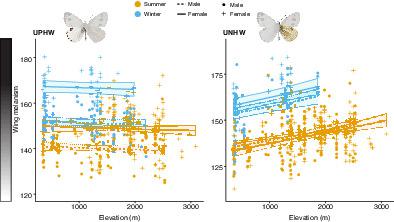当前位置:
X-MOL 学术
›
Ecol. Entomol.
›
论文详情
Our official English website, www.x-mol.net, welcomes your
feedback! (Note: you will need to create a separate account there.)
Adaptive plasticity in wing melanisation of a montane butterfly across a Himalayan elevational gradient
Ecological Entomology ( IF 2.0 ) Pub Date : 2020-07-15 , DOI: 10.1111/een.12911 Shubham Gautam 1, 2 , Krushnamegh Kunte 2
Ecological Entomology ( IF 2.0 ) Pub Date : 2020-07-15 , DOI: 10.1111/een.12911 Shubham Gautam 1, 2 , Krushnamegh Kunte 2
Affiliation

|
Traits that are significant to the thermal ecology of temperate or montane species are expected to prominently co‐vary with the thermal environment experienced by an organism. The Himalayan Pieris canidia butterfly exhibits considerable variation in wing melanisation. We investigated: (i) whether variation in wing melanisation and (ii) activity period of this montane butterfly was influenced by the seasonally and elevationally changing thermal landscape. We discovered that wing melanisation varied across elevation, seasons, sex, and wing surfaces, with the variation strongly structured in space and time: colder seasons and higher elevations produced more melanic individuals. Notably, melanisation did not vary uniformly across all wing surfaces: (i) melanisation of the ventral hindwing co‐varied much more prominently with elevation, but (ii) melanisation on all other surfaces varied with seasonal changes in the thermal environment. Observed wing surface‐specific patterns indicated thermoregulatory function for this variation in melanisation. Such wing surface‐specific responses to seasonal and elevational variation in temperature have rarely been reported in montane insects. Moreover, daily and seasonal thermal cycles were found to strongly influence activity periods of this species, suggesting the potential limits to wing melanisation plasticity. Overall, these results showed that the seasonal and elevational gradients in temperature influence the thermal phenotype as well as activity periods of this Himalayan butterfly. It will be critical to study the phenotypic evolution of such montane insects in response to the ongoing climate change, which is already showing significant signs in this iconic mountain range.
中文翻译:

跨越喜马拉雅海拔梯度的山地蝴蝶翅膀黑化的适应性可塑性
对温带或山地物种的热生态学具有重要意义的特征预计会与生物体经历的热环境显着共同变化。Himalayan Pieris canidia 蝴蝶在翅膀黑色化方面表现出相当大的变化。我们调查了:(i)这种山地蝴蝶翅膀黑化的变化和(ii)活动期是否受到季节性和海拔变化的热景观的影响。我们发现机翼黑色化在海拔、季节、性别和机翼表面上有所不同,这种变化在空间和时间上具有很强的结构性:较冷的季节和较高的海拔会产生更多的黑色个体。值得注意的是,所有翅膀表面的黑色化变化并不均匀:(i)腹侧后翅的黑色化随着高度的共同变化更加显着,但是 (ii) 所有其他表面的黑化程度随热环境的季节性变化而变化。观察到的机翼表面特定模式表明这种黑化变化的体温调节功能。在山地昆虫中很少报道这种对温度的季节性和海拔变化的机翼表面特异性反应。此外,发现每日和季节性热循环强烈影响该物种的活动期,表明翅膀黑化可塑性的潜在限制。总体而言,这些结果表明,温度的季节性和海拔梯度会影响这种喜马拉雅蝴蝶的热表型和活动期。研究此类山地昆虫的表型进化以应对持续的气候变化至关重要,
更新日期:2020-07-15
中文翻译:

跨越喜马拉雅海拔梯度的山地蝴蝶翅膀黑化的适应性可塑性
对温带或山地物种的热生态学具有重要意义的特征预计会与生物体经历的热环境显着共同变化。Himalayan Pieris canidia 蝴蝶在翅膀黑色化方面表现出相当大的变化。我们调查了:(i)这种山地蝴蝶翅膀黑化的变化和(ii)活动期是否受到季节性和海拔变化的热景观的影响。我们发现机翼黑色化在海拔、季节、性别和机翼表面上有所不同,这种变化在空间和时间上具有很强的结构性:较冷的季节和较高的海拔会产生更多的黑色个体。值得注意的是,所有翅膀表面的黑色化变化并不均匀:(i)腹侧后翅的黑色化随着高度的共同变化更加显着,但是 (ii) 所有其他表面的黑化程度随热环境的季节性变化而变化。观察到的机翼表面特定模式表明这种黑化变化的体温调节功能。在山地昆虫中很少报道这种对温度的季节性和海拔变化的机翼表面特异性反应。此外,发现每日和季节性热循环强烈影响该物种的活动期,表明翅膀黑化可塑性的潜在限制。总体而言,这些结果表明,温度的季节性和海拔梯度会影响这种喜马拉雅蝴蝶的热表型和活动期。研究此类山地昆虫的表型进化以应对持续的气候变化至关重要,











































 京公网安备 11010802027423号
京公网安备 11010802027423号